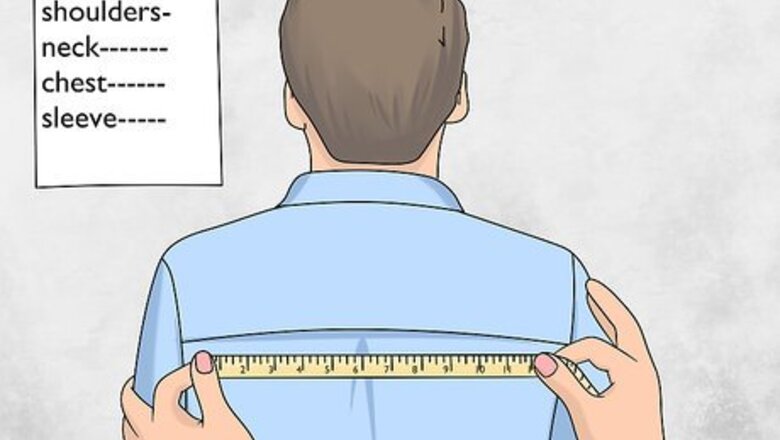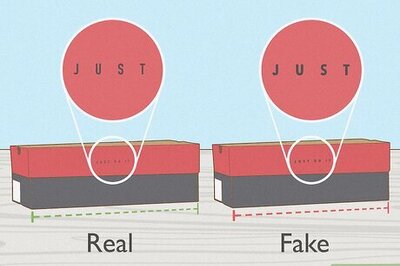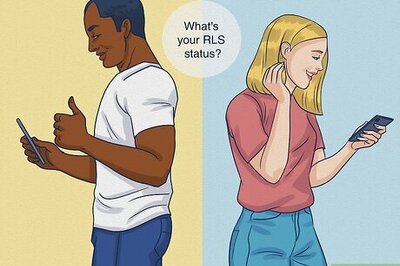
views
Choosing Your Suit Design

Take measurements to determine what size suit to make. Taking measurements will ensure that you pick the correct size pattern for your suit, so do this first. Use a soft measuring tape to measure the across the shoulders, around the neck, chest, and waist, and the length of the jacket, sleeves, and pant inseam. Record all of your measurements on a piece of paper so you can refer back to them when consulting patterns. To get the jacket length, have the person stand with their arms hanging at their sides. Measure from the base of their neck down to their thumb knuckle.Tip: If you’re sewing a suit for yourself, ask a friend to take your measurements. It can be difficult to get accurate measurements on yourself.

Select the style of the suit you want to make. There are several different styles of suits to choose from. Consider when and where you plan to wear the suit. Some suit types you might choose from include a: 2-button blazer for everyday wear, such as for work and important meetings. Tuxedo for formal occasions, such as black tie events and weddings. 3-piece suit, which includes a vest along with the jacket and pants. This might be ideal for a winter suit. Lightweight summer suit to keep you cool during the warmer months.

Purchase a pattern for the suit. You’ll need to use a pattern since making a suit requires using precision cuts of fabric and connecting those pieces in a specific manner to create a well-tailored suit. Choose a suit pattern in your desired style and size. You can find suit patterns in a craft supply store, fabric and sewing supply store, or online. If you do not want to purchase a pattern, there are free suit patterns that you can download and print. Just search the internet for the type of suit pattern you want.

Choose fabric and additional materials for the suit. Look at the envelope on your pattern to determine what type of fabric to buy and how much you’ll need. The envelope will also list additional materials you’ll need, such as buttons, zippers, thread, etc. Opt for a heavyweight fabric to make your blazer, unless you are creating a summer suit, and then use a medium weight fabric instead. Heavyweight fabric choices for blazers include wool, tweed, velvet, and corduroy. Medium weight choices include linen and cotton. The higher the quality of the fabric you choose, the easier it will be to sew.
Cutting the Pattern and Fabric

Read the sewing pattern’s instructions carefully. Before you begin, read through all of the instructions that came with your pattern. Reading the instructions allows you to preview the project, make sure that you have all the needed supplies, and note any important information about the pattern, such as what the symbols on the pattern mean. If there’s anything that’s unclear about the pattern, ask someone who has experience sewing suits to explain it to you. For example, you could ask a friend or family member for help or pose the question on an online forum for tailors.

Cut out the suit pattern pieces in the desired size. Check the pattern’s instructions to identify the pattern pieces you will need. Before you cut out the pattern pieces, trace along the desired size lines with a red pencil or highlighter. This will help to ensure that you cut out the pieces in the correct size. Then, use a sharp pair of scissors to cut along the lines. Different groups of pattern pieces for a design are usually indicated by letters, such as A, B, and C. For example, if you’re making a 2-piece suit, you’d only need the pieces for the jacket and pants, but if you’re making a 3-piece suit, you’d need the pieces for the jacket, pants, and vest. The 2-piece suit might be marked with an A while the 3-piece suit pieces might have an A and B or just a B on them. Cut slowly and carefully to avoid creating any jagged edges or going over your desired size lines.

Pin the paper pattern pieces to your fabric as indicated by the pattern. Once you have cut out the pattern, pin the pieces onto your fabric according to the pattern’s instructions. You’ll likely need 2 of some of the pieces, so fold the fabric first and then pin the pieces to the folded fabric. Be sure to follow any special instructions that the pattern includes for how to pin the pieces onto the fabric. For example, you may need to pin certain pieces along a folded edge and avoid cutting that edge of the fabric. This is common for the back panel of jackets and vests since they tend to require larger cuts of fabric.Tip: If your material is delicate, place weights on the pattern pieces instead. Avoid putting pins through the fabric, which may damage it.

Cut along the edges of the paper pattern pieces. Once the paper pattern pieces are secured to the fabric, use a sharp pair of fabric scissors to cut the fabric. Follow the edges of the paper pattern pieces as you cut the fabric. Go slowly to avoid creating any sharp edges or going over the edges of the paper. Make sure to cut any notches out of the fabric that are indicated along the edges of the paper pattern pieces. These are important for lining up your pieces when you sew them together. Don’t remove the paper pattern pieces from the pieces you cut out right away. Keep them in place so that you will be able to tell the different pieces apart.
Sewing the Pieces Together

Transfer the pattern markings to your fabric pieces. Once you finish cutting out that pattern pieces, look to see if there are any special markings on the pattern that you should transfer to the fabric before you sew. These may include markings for buttonholes or darts to indicate pleats. If you spot any of these special symbols on the interior of a pattern piece, use a piece of fabric chalk or a fabric marker to trace them onto the fabric pieces. For example, the front panels of the suit’s jacket will likely have markings for buttonholes and button placement that you’ll need to indicate on the front panel pieces.

Pin the pieces together according to the pattern’s instructions. Before sewing the pieces together, check your pattern’s instructions for how to pin certain pieces together. In most cases, you’ll be pinning the pieces with the right sides facing each other so that the fabric’s raw edges will be hidden on the inside of the suit. Insert pins perpendicular to the edges of the fabric where indicated by your sewing pattern. Place 1 pin every 2 to 3 in (5.1 to 7.6 cm) along the edges of the pieces. For example, if you’re attaching one of the front panels for the suit jacket to the back panel, you’ll need to pin the pieces starting along the edges of the 2 pieces that will go under the armpit and go all the way to the bottom of the 2 pieces.

Sew a straight stitch along the pinned edges. Once you have pinned a piece or multiple pieces together, take them to your sewing machine. Set the machine to the straight stitch setting, which is setting number 1 on most sewing machines. Then, raise the presser foot on the machine and place the fabric under it. Lower the presser foot and sew a straight stitch along the edge to connect the fabric pieces. Make sure to remove the pins as you sew. Do not sew over the pins or you may damage your sewing machine. Repeat this to connect all of the other suit pieces together.

Fit and hem the pants and jacket sleeves. After you’ve finished sewing together all of the suit pieces, you’ll need to hem some parts of the suit. Before you do this, have the person who will be wearing the suit try it on as is. Then, fold over and pin the pants and jacket sleeves up to the desired points before you hem them. Sew a straight stitch about 0.5 in (1.3 cm) from the raw edges of the fabric to hem the jacket sleeves and pant legs.Tip: If you’re making a suit for yourself, have a friend help you fit the suit while you’re wearing it.

Add buttons and zippers where indicated on the pattern. Once you have finished sewing the suit jacket, pants, and vest (optional) together, you’ll need to attach the buttons to the suit jacket and vest (optional) and add a zipper onto the pants. Follow your pattern’s instructions for where to place these items. You can sew buttons on by hand or with a sewing machine, but you’ll need to use a sewing machine for the zipper. If you transferred any markings from the paper pattern pieces to the fabric, these will serve as helpful guides for where to create buttonholes and sew buttons onto. Sewing the pockets, buttonholes, and flaps by hand will make the jacket look more tailored and high-value.

Pair the suit with a shirt and tie to complete the look. Once the suit jacket and pants are complete, the suit is ready to wear. Select a dress shirt and tie to go with the suit. Dress shirts and ties are widely available in a wide range of colors and prints. Choose a dress shirt and tie that will complement the color of the suit. You can purchase a tie to wear with the suit or make your own tie if you want.


















Comments
0 comment